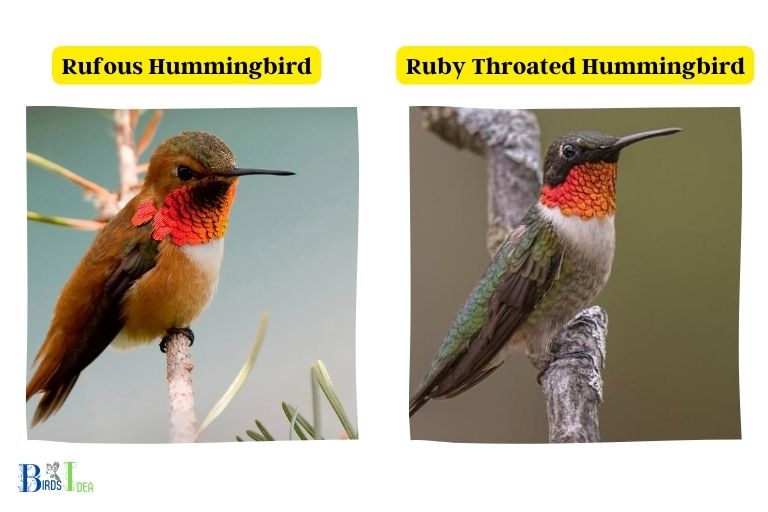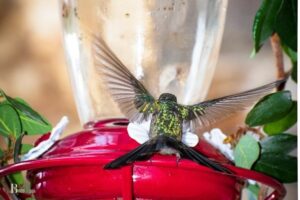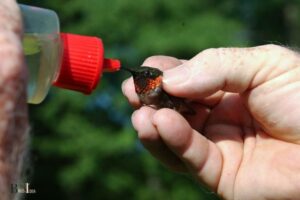Rufous Hummingbird Vs Ruby Throated: American!
Rufous Hummingbird and Ruby-throated Hummingbird are two of the most common North American hummingbirds.
Though very similar in size and appearance, they have several distinct characteristics that set them apart.
The Rufous hummingbird (Selasphorus rufus) gets its name from its bright orange or rufous color.
These birds are known for their long migration route, extending up to 2,000 miles from Alaska to Mexico.
The Ruby-throated hummingbird (Archilochus colubris), having a ruby-red throat, is the only hummingbird species that breed in the eastern United States and Canada.
These birds migrate to Central America for the winter.
Though similar in many ways, Rufous Hummingbirds and Ruby-throated Hummingbirds have their own unique characteristics and behavior patterns, making them easily distinguishable from one another.
From their size and plumage to their habitat and migration patterns, these two species of hummingbirds have plenty to offer birdwatchers and nature enthusiasts.
10 Features of Rufous Hummingbird and Ruby Throated Hummingbird
| Feature | Rufous Hummingbird | Ruby Throated Hummingbird |
| Scientific Name | Selasphorus rufus | Archilochus colubris |
| Average Length | 3.1 in (8 cm) | 2.8 – 3.5 in (7 – 9 cm) |
| Wingspan | 4.3 in (11 cm) | 3.1 – 4.3 in (8 – 11 cm) |
| Average Weight | 0.1 – 0.2 oz (2 – 5 g) | 0.1 – 0.2 oz (2 – 6 g) |
| Migratory Pattern | Migrates to Alaska in summer and Mexico in winter | Migrates to North America in summer and Central America in winter |
| Color | Male: Rusty-orange; Female: Green upper parts and rusty flanks | Male: Emerald green back and fiery red throat; Female: Green upper parts and white under parts |
| Lifespan | Average 3 – 5 years | Average 5 – 9 years |
| Habitat | Forest edges, meadows, parks, gardens | Deciduous and pine forests, orchards, gardens |
| Diet | Nectar, insects, spiders | Nectar, insects, spiders |
| Nesting | Female builds nest; 2 eggs per clutch | Female builds nest; 1 – 3 eggs per clutch |
Key Takeaway

Five Facts About: Rufous Hummingbird and Ruby Throated Hummingbird
DID YOU KNOW
“The more we get to know about the diversity of hummingbirds, the better stewards we can be of these enchanting creatures.”
Rufous Hummingbird and Ruby-throated Hummingbird
The Rufous Hummingbird and the Ruby-throated Hummingbird are two of the most beautiful species of hummingbirds in North America. They are very similar in size, shape, and behavior but have some significant differences.

Rufous Hummingbird:
- Smaller than Ruby-throated Hummingbird
- Longer and curved bill
- Variable plumage
- Found in western North America
- Feeds on a wide variety of insects and nectar
Ruby-throated Hummingbird:
- Larger than Rufous Hummingbird
- Short and straight bill
- Distinctive coloring with red throat
- Found in eastern North America
- Visits hummingbird feeders for nectar
These two species of hummingbirds are both fascinating to watch and a delight to have around.
While they may look similar, they have some distinct differences that make them stand out and easy to identify.
Comparison between Rufous Hummingbird and Ruby Throated Hummingbird
Rufous hummingbird and Ruby-throated hummingbird are two common species of hummingbirds found in North America.
Both birds are similar in size, with a length of three to four inches and an average weight of just two grams.

The primary difference between the two species lies in their physical attributes and habitat preferences.
The Rufous hummingbird has an overall rufous-orange coloration, with a white breast and dark wings. In contrast, the Ruby-throated hummingbird has a white underside and green wings.
The Rufous hummingbird prefers mountainous and coastal regions in northern climates, while the Ruby-throated hummingbird prefers temperate deciduous forests and other open habitats in the eastern United States and Canada.
In terms of diet, the Rufous hummingbird feeds primarily on nectar and insects, while the Ruby-throated hummingbird feeds more heavily on insects.
The Rufous hummingbird also has a longer bill, which helps it feed on the deeper nectars of some flowers.
“The more we get to know about the diversity of hummingbirds, the better stewards we can be of these enchanting creatures.”
birdsidea
Size Difference between Rufous Hummingbird and Ruby Throated Hummingbird
The Rufous Hummingbird and Ruby-throated Hummingbird are among the most popular types of hummingbirds.
Although they belong to the same family, they differ in size — the Rufous Hummingbird being larger than the Ruby-throated Hummingbird.

Size Difference:
- The Rufous Hummingbird is 3-3.75 inches in length, while the Ruby-throated Hummingbird is only 2.75-3.25 inches in length.
- The Rufous Hummingbird has a wing span of 4.3 inches (11 cm), while the Ruby-throated Hummingbird’s wing span is only 3.54-3.94 inches (9-10 cm).
- The Rufous Hummingbird weighs about 3.4-4.0 grams, while the Ruby-throated Hummingbird weighs about 2.5-3.7 grams.
In addition to size, the two species also differ in their coloration, with the Rufous Hummingbird having an orange-red plumage and the Ruby-throated Hummingbird having a more muted green and white coloration.
Despite their differences in size and color, both species of hummingbird are remarkable creatures, and it is important to protect them and their habitats.
Color Difference between Rufous Hummingbird and Ruby Throated Hummingbird
The Rufous Hummingbird and Ruby-throated Hummingbird are two different species of hummingbirds that are found in North America.
Although they are both small birds, they are easily distinguishable by their physical features and differences in color.

The major difference between these two birds is their color. The Rufous Hummingbird has an overall rufous-brown plumage and a dark head, while the Ruby-throated Hummingbird has an overall greenish-white and tan plumage, with a white throat.
Additionally, the Rufous Hummingbird has a black bill, while the Ruby-throated Hummingbird has a red bill.
The following are the main differences in color between the two species:
- Rufous Hummingbird: Rufous-brown plumage, with a dark head and a black bill.
- Ruby-throated Hummingbird: Greenish-white and tan plumage, with a white throat and a red bill.
Habitat Choices of Rufous Hummingbird and Ruby Throated Hummingbird
Rufous and Ruby-throated hummingbirds are two species of nectar-feeding birds found in North America.
Both species are migratory, with the Rufous hummingbird wintering in Mexico and the Ruby-throated hummingbird wintering in Central America.

Both species live in different habitats throughout the year and migrate to different regions, so it is important to understand the habitat choices of each to properly identify them.
Habitat Choices of Rufous Hummingbird:
- Rufous hummingbirds breed in northern areas of North America and migrate south to Mexico in the winter.
- They inhabit open areas of brush, woodland edges, and scrubland.
- During the breeding season, they prefer riparian habitats with taller vegetation and dense canopies.
Habitat Choices of Ruby-Throated Hummingbird:
- Ruby-throated hummingbirds breed in the eastern United States and migrate south to Central America in the winter.
- They inhabit open areas of brush, woodland edges, and scrubland.
- During the breeding season, they prefer deciduous and coniferous forests with smaller trees and shrubs.
Both Rufous and Ruby-throated hummingbirds are attracted to feeding stations with sugary drinks.
Feeders with red flowers or red dye may attract hummingbirds, and they may also be attracted to water sources.
In the summer months, hummingbirds will feed on insects while they are migrating, but they are mainly nectar feeders
Similarities between Rufous Hummingbird and Ruby Throated Hummingbird
Rufous and Ruby-throated hummingbirds are two of the most common species found in North America. Both of these birds share many similarities, despite the fact that they look different.

The similarities between these two hummingbirds include:
- Appearance: Both hummingbirds have a slender body and a small head. They also have a long beak and wings.
- Diet: Both species feed on nectar, insects, and spiders.
- Mating Habits: Both hummingbirds perform complex courtship displays to attract mates.
- Nest Building: Both species build cup-shaped nests in trees and shrubs.
The most notable difference between the Rufous and Ruby-throated hummingbird is their coloring.
The Rufous hummingbird has a rufous-brown back, while the Ruby-throated hummingbird has a bright green back. Additionally, the Rufous species is slightly larger than the Ruby-throated species.
Overall, the Rufous and Ruby-throated hummingbird species have many similarities, with the most significant difference being their coloring.
Migration Patterns of Rufous Hummingbird and Ruby Throated Hummingbird
Rufous Hummingbird and Ruby Throated Hummingbird are two distinct species of hummingbirds. Both of them migrate for the winter season.

Migration of Rufous Hummingbird:
- Rufous Hummingbirds migrate from breeding grounds in western North America to Central and South America for winter.
- They usually take a single long-distance flight that can last up to 20 hours and cover more than 2,000 miles.
- Rufous Hummingbirds often migrate in small groups, called “flocks”, consisting of 5 to 20 birds.
Migration of Ruby Throated Hummingbird:
- Ruby Throated Hummingbirds migrate from their breeding grounds in eastern North America to Central America for winter.
- They fly between 500 to 1,000 miles in a single flight, which may last up to 18 hours.
- Ruby Throated Hummingbirds generally migrate alone and do not form flocks.
Rufous and Ruby Throated Hummingbirds are two unique species that have distinct migration patterns.
Rufous Hummingbirds migrate from western North America to Central and South America for the winter season in small flocks, while Ruby Throated Hummingbirds migrate from eastern North America to Central America in solo flights.
Diet of Rufous Hummingbird and Ruby Throated Hummingbird
Rufous and Ruby-throated hummingbirds are two species of hummingbirds found in North America.
Both species have a small, slender body, long beak, and wings that beat rapidly, enabling them to hover in midair. While they share some similarities in appearance and behavior, they have different diets.

- Rufous Hummingbird Diet:
- Rufous hummingbirds have a mainly insect-based diet, which they supplement with nectar from flowers. They particularly enjoy consuming aphids, small flies, beetles, moths, and spiders.
- Ruby-throated Hummingbird Diet:
- Ruby-throated hummingbirds prefer a diet of nectar and small insects such as spiders, flies, and beetles. They also consume sap from trees, sugary fruits, and small tree frogs.
Both species need to consume energy-dense food sources to fuel their fast-paced lives and high metabolism. To do this, they feed several times a day and store energy reserves in their bodies to help them during their long migrations.
FAQ of Rufous Hummingbird Vs Ruby Throated
What is the difference between a Rufous Hummingbird and a Ruby Throated hummingbird?
Ruby Throated hummingbirds are non-migratory and stick to areas of North America east of the Rocky Mountains.
Rufous hummingbirds are larger in size and have a rusty brown back, while Ruby Throated hummingbirds have a greenish bronze back.
Where do Rufous and Ruby Throated hummingbirds live?
Ruby Throated hummingbirds are found east of the Rocky Mountains, primarily in the United States and Canada.
What do Rufous and Ruby Throated hummingbirds eat?
How can I tell a Rufous hummingbird apart from a Ruby Throated hummingbird?
In addition, Rufous hummingbirds have an orange-red throat and a white head, while males of the Ruby Throated species have a throat patch of iridescent red.
What time of year do Rufous hummingbirds migrate?
They move south reaching as far as Mexico during the winter months before returning to their northern home range in spring.
Conclusion
Despite having many similarities, Rufous and Ruby-throated hummingbirds have some clear distinctions in size, color, and their choice of habitats.
Understanding these distinctions can help us better protect and appreciate both species.






